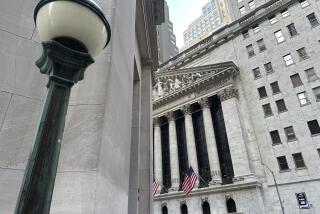Bonds Faring Better During Asian ‘Flu’
- Share via
Asia’s financial mess has been poison to world stock markets, but it has been a tonic for bonds.
Yields on government bonds of major Western nations have tumbled in recent weeks as some investors have bought into two assumptions: First, that global economic growth is going to slow in 1998, dragged down by Asia; and second, that if something worse than a worldwide slowdown should occur--such as a deep recession--government bonds are likely to be among the few “safe” investments.
The yield on the 30-year U.S. Treasury bond, a benchmark for long-term interest rates in general, has plunged from 6.61% at the end of August to 6.06% as of Monday, which is just above the 21-month low of 6.03% set last week.
Yields also have declined on many U.S. corporate and municipal issues in recent months and on Western European bonds as well.
For individuals who have been heavily invested in stocks since 1994, bonds have at best been an afterthought. Why own bonds, paying relatively paltry annual yields of 5% to 8%, when the stock market is generating returns of 20% or better per year?
*
What has changed in recent months, of course, is that a growing number of investors are questioning how much the U.S. stock market can rise next year, if at all, should Asia’s debacle weaken the global economy and thus corporate profits.
If stocks’ returns are going to shrink--or worse, if the market should dive--those 5% to 8% yields on bonds may suddenly look far more lucrative.
What’s more, bonds offer the potential for capital appreciation: If market interest rates decline further in a weakening economy (as demand for money falls), a bond paying 6% annual interest will naturally be worth more if newly issued bonds of similar terms are paying, say, 5.5% interest.
Yet deciding whether, and what, to buy in the bond market is no simpler a process than deciding on stocks. In fact, bonds may be the more complicated decision.
Why? A bond investor has to consider the risk of higher inflation sometime in the future, which could erode the value of a fixed-rate return. And now, because of Asia, there is the new risk of deflation, which could affect different types of bonds in different ways (more on that later).
There also is “credit risk,” which is the risk that a bond issuer might default on interest or principal payments. And there are tax considerations: Bond interest (other than on tax-exempt municipal issues) is taxable as ordinary income, while long-term capital gains on stocks are taxed at much lower rates.
*
The biggest risk of all may be that the assumptions about world economic growth in 1998 are dead wrong, and that strength in the United States and Europe more than compensates for Asia’s weakness. If that’s the case, the Federal Reserve Board and European central banks may be compelled to boost short-term interest rates next year to keep growth and inflation at manageable levels.
The German central bank, the Bundesbank, in fact raised short-term rates modestly in early autumn, which sent bond yields higher across Europe--but not for long, as Asia’s turmoil quickly took center stage.
Despite all of the above concerns, there obviously have been plenty of buyers chasing bonds in recent weeks. For many investors, the issue may simply be one of diversification: Because they earn a decent rate of interest, bonds can provide an element of stability for a portfolio that stocks can’t.
Few financial advisors would suggest that an investor dump most of his or her stocks to buy bonds. But many advisors believe that basic diversification calls for holding 20% to 30% of a total portfolio in bonds or some other income-generating investment--especially in the case of investors past the age of 50, for whom capital preservation becomes more of a concern.
If you’re mulling the bond decision, here’s a look at the three major categories of bonds and what to consider in shopping for securities in each category:
* U.S. Treasuries. These are the most liquid type of bond in the world--they’re the easiest to buy and sell on the open market, in denominations as low as $1,000. Their interest is exempt from state income tax (though not federal). They’re also considered to have the lowest risk of default: Almost nobody believes Uncle Sam will ever miss a debt payment.
For these reasons, Treasuries benefit from the “flight to quality” that occurs in times of crisis.
That’s partly what has driven Treasury yields lower in recent weeks. And those yields have become compressed. The difference in yields among shorter-term and longer-term securities isn’t very wide today.
A Treasury note maturing in two years now yields 5.71% annually. A five-year T-note yields 5.79%. So you’re earning little additional yield for taking the added risk of “locking up” your money for five years rather than two.
Then why buy a longer-term issue? Because if economic growth does slow sharply in 1998, yields may go much lower.
“We’re bullish [on interest rates declining] so we think you should go out as long as you can” in bond maturity, says Michael Kennedy, a bond fund manager at Stein Roe Inc. in Chicago.
Analysts who expect falling long-term interest rates in 1998 point not just to lower economic growth expectations, but also to the 1.8% U.S. consumer inflation rate so far this year. With inflation this low--and threatening to become deflation (i.e., falling consumer prices)--the bullish argument is that real (after-inflation) long-term bond yields are far too high, historically.
“If you look back to the 1950s [the last time inflation was this low], you could see how we might be ultimately headed for a 5% yield on 30-year Treasuries,” says Stephen Slifer, economist at Lehman Bros. in New York.
If the bulls are wrong, however, and market rates rise next year instead of falling, the principal value of longer-term securities will decline more than will that of shorter-term securities (although you’ll still get whatever fixed interest rate your bond pays).
Rather than pick a single maturity, many investment pros have a better idea: “We recommend that people ‘ladder’ their bonds,” says Paula Kohl, head of government securities trading at brokerage A.G. Edwards in St. Louis.
In other words, build a portfolio of Treasury issues, with some maturing, say, in two years, some in four years, some in six years, etc.
Any brokerage can sell you Treasuries. For information on buying direct from the Federal Reserve, call the Fed at (213)-688-0068.
Investors who don’t have the wherewithal to buy individual Treasury issues can buy Treasury bond mutual funds. They offer convenience and immediate access to your money, and there are plenty of choices, with some funds focusing on short-term securities, others on intermediate-term securities and still others on longer-term issues.
The problem with the funds is that they don’t afford you the same control. Their interest returns can fluctuate, and the portfolio may be constantly changing as the fund manager buys and sells securities, trying to outguess the market.
Finally, there’s a risk that Treasuries overall face today: If troubled Asian nations, which own hundreds of billions of dollars in Treasury debt, begin to dump those bonds to bring cash home, Treasury market yields could surge.
But many experts doubt that Asian nations, and their central banks, will want to sell a significant portion of their bonds. And even if they do, bond fund manager John Queen at Hotchkis & Wiley in Los Angeles notes that demand from other investors may easily absorb that selling--especially with the Treasury issuing far less new debt as the federal budget deficit has shrunk dramatically.
* Corporate and mortgage-backed bonds. Some Wall Street pros believe that the best bond buys today are in corporate and mortgage-backed issues, which may yield anywhere from 0.50 point to 3 full percentage points above what Treasury issues of similar maturities pay.
Because investors are worried about the economy weakening next year, they are naturally demanding higher yields on bonds of issuers that may be vulnerable to a slowdown.
The threat of global deflation because of devalued Asian currencies is a new risk: U.S. companies that face an avalanche of cheap imports from Asian competitors could be slammed financially.
“There’s been a lot of dislocation [in the corporate bond market] recently,” said Hotchkis & Wiley’s Queen. Yet he notes, “That creates a lot of opportunity too.”
But the corporate and mortgage area is far tougher for the individual investor to navigate without help, especially if you want to buy individual securities. Your best bet: Use a mutual fund to make a corporate bond investment, or get a financial advisor’s help.
* Tax-exempt municipal bonds. For higher-income investors in California, munis issued by the state or by local or regional municipalities almost always offer great competition for taxable Treasury issues and other bonds.
Ten-year state general obligation bonds yield about 4.7%, tax-free, currently. If your combined federal and state marginal tax bracket is in the 35% range, that yield is equivalent to a 7.2% yield on a fully taxable bond.
And munis may have something else going for them now: If investors are looking for securities that aren’t directly at risk from Asia’s fallout, munis should be bright on the radar screen.
As with corporate bonds, you will probably need a financial advisor’s help to select individual munis. They’re also easy to own via mutual funds. Fund companies including Franklin Templeton (phone [800] 342-5236), Fidelity ([800]-544-8888), Nuveen ([800] 351-4100) and Putnam Funds ([800] 225-1581), to name but a few, offer California muni bond fund choices.
(BEGIN TEXT OF INFOBOX / INFOGRAPHIC)
How Yields Have Tumbles
U.S. Treasury bond and note yields have fallen sharply in recent months as investors have bey that Asia’s economic turmoil will lead to slower growth worldwide in 1998. Also, a “flight to quality” has helped push Treasury rates down. Month-end yields and latest for the two-year T-note and the 30-year T-bond.
30-year Treasury bond. 1997 Monday: 6.06%
Two-year Treasury note. 1997 Monday: 5.71%
* Source: Bloomberg News.
More to Read
Inside the business of entertainment
The Wide Shot brings you news, analysis and insights on everything from streaming wars to production — and what it all means for the future.
You may occasionally receive promotional content from the Los Angeles Times.










